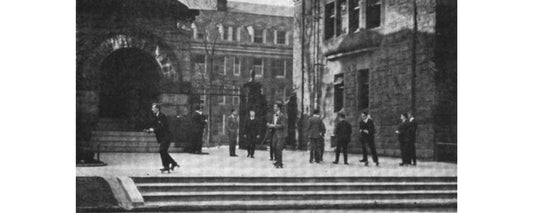“The Sleeping Giant was awake. He must be awake because he was gone. Of course he might just be walking in his sleep.”
So begins Eleanor Estes’s 1948 anthology The Sleeping Giant and Other Stories. Born and raised in West Haven, Estes was a beloved author of 18 books for children, including one awarded a Newbery Medal for “the most distinguished contribution to American literature for children.” Forgotten today by many, Estes’s stories continue to hold a special charm for New Haven-area audiences who’ll recognize the town she called “Cranbury.”
The Boston Post Road, Sleeping Giant, East Rock, West Rock and other familiar locales play a role in many of Estes’s stories. Originally published in 1951, her Newbery winner, Ginger Pye, is the story of sister and brother Rachel and Jerry Pye, who go in search of their missing dog, Ginger. The children’s adventures while looking for Ginger include an attempt to climb the sheer rock face of East Rock. When this proves impossible, they settle for the next-best alternative: climbing up the Giant Steps, which still mount the east side of the cliff today. At the top, the children admire the monument and a cannon, “the breathtaking view of the city” and a little zoo with a bear and raccoons and a gnu. There’s no sign of Ginger the dog.
sponsored by
Following a small trolley fire in the next chapter, a trip up West Rock leads to the disappointing discovery that Judges Cave isn’t much of a cave at all, but instead a pile of boulders surrounded by an iron fence. Ginger isn’t in Judges Cave either.
Ginger Pye is full of digressions and extended flashbacks to earlier incidents—jumping off a barn roof into a pile of hay, swimming with eels, putting out a fire during a Christmas pageant—only tangentially related to the plot at hand. On a blog for UConn’s Thomas J. Dodd Research Center, philosopher Claudia Mills wrote that, after spending a week reading through Estes’s papers there, she concluded the author was interested “less
“The Sleeping Giant” is full of such observations, though they’re spoken in this case not by a child but by the narrator. Hamden’s famous land form gets tired of having his head quarried and rises up, leaving a “dark red hollow where
sponsored by
A little boy named Jimmy is the first to realize that the Giant has found a new resting spot in the ocean, lying across the International Date Line. Embarking on a retrieval quest by boat, Jimmy is accompanied by the “ladies of the Adelpha Delphie Club,” who had tried to save the Giant from quarrying and whose “irate husbands” insist, “There are no islands on the date line!” After numerous adventures (spoiler alert), their mission is successful, and they tow the “floating giant” home by way of the Panama Canal. Back in the Mount Carmel section of Hamden, “Jimmy was positive he saw the giant open one big green eye, look around, smile and slip back into his dreams. But no one believed Jimmy although he had been right about so many things.”
Estes’s most famous book, The Hundred Dresses (1944), tells the story of an outsider who is mercilessly teased by the other girls at school for her boast that she has a hundred dresses, though every day she wears the same old dress. After she moves away, her classmates learn there was truth to her tale and feel the shame of their mistreatment of her. The story was based on an incident from Estes’s own life, her daughter wrote in a “letter to readers” in later editions of the book.
“She told me about a classmate in her elementary school who had been taunted because she wore the same dress to school every day, and because her Polish name was unusual and difficult for many to pronounce,” Helena Estes wrote. “My mother was in school during World War I, and Polish names were uncommon then in the small town of West Haven, Connecticut… This little girl moved away to New York City in the middle of the school year, and my mother, as sometimes happens in real life, did not have the opportunity to tell her she was sorry.”
Like many writers of her time, Estes is occasionally politically incorrect by today’s standards. But The Hundred Dresses, at least, has remarkable sticking power. As recently as 2007, the National Education Association listed it as one of “Teachers’ Top 100 Books for Children.” The book has reportedly sold more than a million copies and continues to be one of its publisher’s best-selling titles.
Eleanor Estes died in Hamden in 1988 at the age of 82. “I am holding up a mirror,” she once told the New York Times, “and the scene reflected in the mirror is a true image of childhood, and the mirror, besides reflecting, also speaks and echoes the clear, profound, unpremeditated utterances… of children.”
Generations of readers have seen themselves in that mirror. But those of us in greater New Haven see more than a reflection of childhood; Estes continues to show us our city and its surroundings as it was in an earlier time, through the imaginative eyes of an inner child who knew it well.
Written by Kathy Leonard Czepiel. Photographed by Kathy Leonard Czepiel and Dan Mims.









